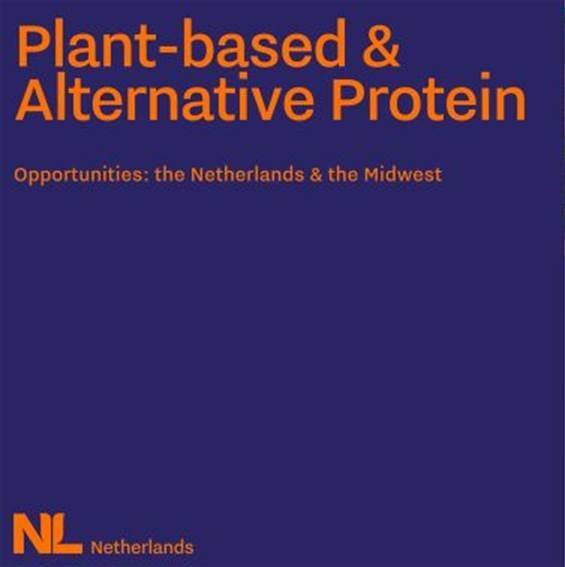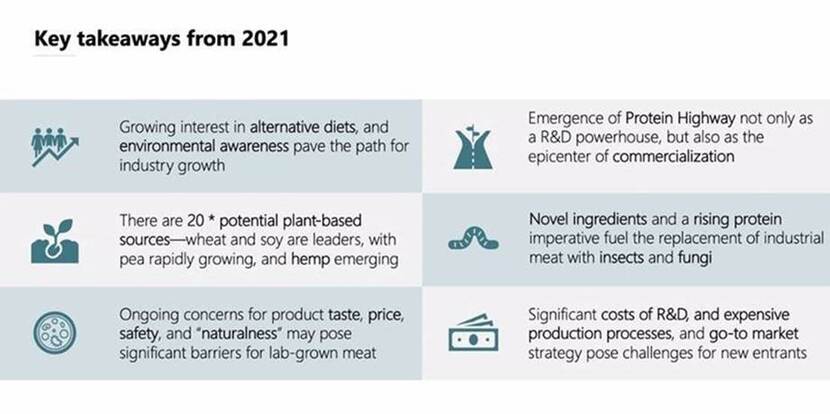Report: Plant Based & Alternative Proteins
The Consulate General of the Netherlands in Chicago and the Netherlands Embassy in Washington D.C together commissioned our partner Sente Foundry to analyze the alternative Protein Sector in the Midwest Region. In March of this year, during a roundtable with key stakeholders from the Dutch alternative protein ecosystem and plant-based proteins, the key results of the report were presented.


The report identified 5 opportunities
Plant-based and fermented meat and fish: The popularity of Beyond Meat and Impossible Foods has validated the market for plant-based meat & dairy. Although a slew of incumbent CPG companies such as Boca and MorningStarFarms have been selling fake chicken products for years, we believe today’s providers are tapping into a different consumer base—one that is more focused on the health, environmental, and ecological impacts of the traditional meat industry. As plant-based proteins continue to increase in sophistication and ability to imitate animal-based meats, fermentation technology has emerged as an innovative tool, lending key sensory characteristics such as meaty taste and texture, in addition to superior digestibility and nutrition profiles. A prime example of these benefits can be found with Meati, a fermented protein provider developing whole cuts of meat analogs such as chicken breasts, steak, and jerky from mycelium. The company piloted its mycelium steak at restaurants in Boulder, Colorado, and is planning its first product launch in 2022. Other key fermented protein products include bacon from AtlastFood Co. and animal-free
Dairy alternatives: Animal-free dairy products are experiencing rapid growth, leading to an increasingly diverse and crowded marketplace. Well-known providers include Silk and Soy Delicious, which sell single-ingredient dairy products made from soy, peas, oats, or nuts. Incumbents are increasingly disrupted by startups including Lavva, Kite Hill, and Forager Project, which are producing new animal-free dairy products that seek to better mimic dairy by improving the sensory characteristics. Some providers are using precision fermentation to produce real dairy without animals. Precision fermentation uses microorganisms as micro-production factories that produce substances identical to animal proteins, fats, and enzymes that can then be used as ingredients. The Urgent Company uses precision fermentation to produce milk proteins, from which it has developed a growing list of animal-free dairy products including ice cream, cream cheese, and sports protein powder. Other startups developing animal-free dairy products using fermentation include SuperbrewedFood, ENOUGH Food, and Nature’s Fynd., whole-cut fish from Aqua Cultured Foods.
Cultivated proteins: Animal meat and dairy manufactured without animals and traditional animal agriculture remains the holy grail of alt-proteins due to the potential health, environmental, ethical, and food security benefits. However, significant challenges stand in the way of mass adoption including regulatory hurdles, production costs, and technological barriers to scaling production and producing a desired end product. Although Eat Just achieved a major milestone in 2020 as the first provider to sell a cultivated meat product after receiving regulatory approval in Singapore, there have been few regulatory advances since then. There remains no clear path to regulatory approval in the US or any other country— Singapore included. However, other cultivated meat companies, including Shiok Meats and Avant Meats, have established facilities in Singapore in anticipation of a friendlier regulatory environment. Other key providers include Future Meat, Upside Foods, and BlueNalu.
Tissue engineering suppliers: Approaches to producing cultivated agriculture are based mainly on existing medical technologies that rely on traditional laboratory equipment and technology. We believe several of these suppliers are significantly exposed to the cultivated agriculture opportunity, including:
- OSPN GmbH: develops modular molecular bioreactors to propagate animal cells
- Culture Biosciences: third-party “biomanufacturing-as-a-service,” including lab testing facilities and a digitalbiomanufacturing platform
- Robur Health: genome-level metabolic modeling
- CELLINK: bioprinting technologies
- 3D Cultures: economic tools for biofabrication and tissue engineering
Novel ingredients and a rising protein imperative: The global population is growing rapidly and is expected to reach 9.7 billion by 2050, according to the United Nations.1 To feed the increasing number of people, new sources of food must be identified, and existing raw materials expanded where feasible. Insects and fungi are two food sources that are less expensive and faster to produce than industrial meat. Investors are funding startups developing production techniques that can scale to meet the growing demand.
Challenges identified in the report
- Regulation, politics, and social backlash: Incumbent animal meat producers are competing with the alternative meat industry across numerous avenues. For example, Missouri prohibited the use of the word “meat” to define food products “not derived from harvested production livestockor poultry.” This would make it illegal to label plant-based meat alternatives as “meat” for marketing or packing purposes without qualifiers that explain the product is plant-based. Additionally, animal meat advocacy groups such as the Missouri Cattlemen’s Association are lobbying to create more regulation of plant-based meat producers.
- Alternative meat development requires significant R&D:R&D represents a considerable barrier to entry for startups, given the high degree of technology needed to develop, produce, and refine plant-based meat. This will keep the pressure on margins, at least in the short term. While scale could increase margins, the industry likely faces commoditization over the long run.
- Expensive production process: Cultivated agriculture technology is based on tools and techniques initially developed in a lab for medical and biotech purposes. As such, the production process is currently performed in tiny batches at great expense. As the technology and production process have matured, costs have plummeted. Several startups are convinced that the price will continue to decline to less than $5 per pound within the next two years, compared to $3 to $4 for regular beef. Despite advancements, scaling for mass production is complicated and may require the advent of new technologies, which will put mass production at least a few years away.
- Sales channel risk: The two largest plant-based meat companies, Beyond Meat and Impossible, initially pursued very different sales strategies. Beyond Meat focused on grocery stores with product placement in the meat section alongside animal meat products. The company has since expanded to restaurants, focusing primarily on fast food. Impossible initially focused on high-end restaurants, partnering with celebrity chefs to showcase the product. The company then expanded into lower-end fast-food restaurants and launched a growing list of CPG products including animal-free beef burgers, meatballs, and chicken nuggets. Targeting high-end restaurants allows companies to achieve greater margins and position their brand as a luxury good. Grocery sales allow access to a larger pool of potential customers, although at higher expense, which may be implausible for early-stage businesses. Restaurant sales have struggled during the pandemic, thus creating additional headwinds for this channel.
- Consumers have an uncertain perception of lab-grown meat: Various studies on consumer perceptions of cultivated agriculture indicate that, despite interest in reducing health risks, environmental harm, and animal welfare issues, concerns for product taste, price, safety, and “naturalness” may pose significant barriers to adoption. Cultivated agriculture advocates must be careful to manage public perception of cultured meat and work to educate consumers on the benefits and considerations of cultivated agriculture versus industrial agriculture.
More information
For more inspiration of the Dutch ecosystem of alternative proteins, the Future of Protein online magazine is a great source of inspiration: Magazine Future Protein NL toont Nederlandse koploperspositie alternatieve eiwitten - Topsector Agri & Food (topsectoragrifood.nl)
Explosieve ontwikkeling plantaardig eiwit in de VS | Verenigde Staten | Agroberichten Buitenland
Link naar Eiwitspecial: Eiwittransitie wereldwijd 6 | uitgave november 2021 | Agrospecials (rijksoverheid.nl)